Seoul is always changing. In what feels like just weeks an old neighborhood is razed and huge new apartment towers stand in its place. This dynamism is part of the city’s excitement. But in this relentless push forward, too many of Seoul’s most historic areas are being destroyed. One example is Pimatgol (피맛골), located in the central Jongno District.
 Big ole Jongno with Pimatgol creating a crease in a sea of tile roofs.
Big ole Jongno with Pimatgol creating a crease in a sea of tile roofs.
The Chinese characters of Pimatgol literally mean “avoid horse alley,” which was the why this narrow passage, just three meters wide in most places, was created some 600 years ago during the Joseon Dynasty.
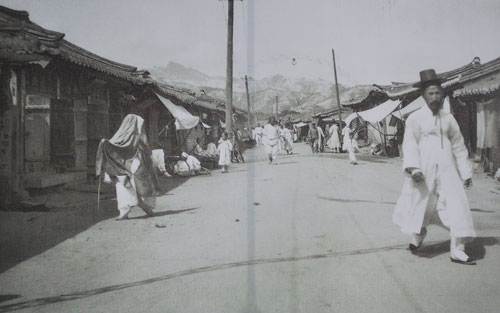 In this photo, dated 1906, dapper gentlemen in white stroll down what’s labeled Pimatgol… but looks awfully wide. What’s the deal with Mr. Blanket?
In this photo, dated 1906, dapper gentlemen in white stroll down what’s labeled Pimatgol… but looks awfully wide. What’s the deal with Mr. Blanket?
Jongno was the main thoroughfare connecting the city, and the frequent passage of aristocrats, called yangban (양반), on horses or in sedan chairs created an inconvenience for the common people, who were required to stop and prostrate themselves as they passed.
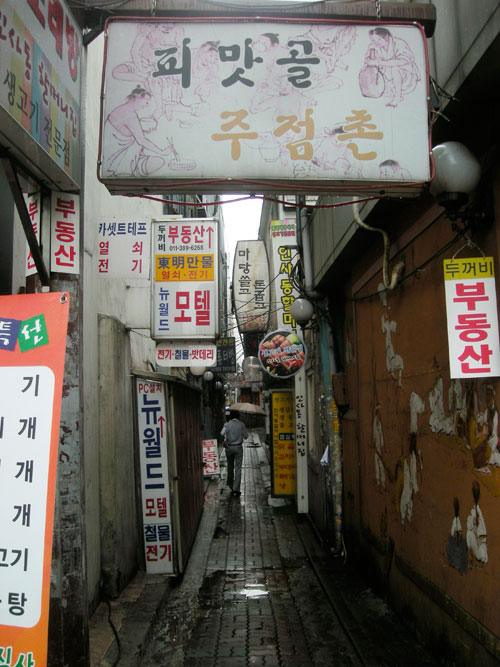 One of the last remaining stretches of Pimatgol, the 600-year-old alley in the heart of downtown Seoul.
One of the last remaining stretches of Pimatgol, the 600-year-old alley in the heart of downtown Seoul.
To avoid this formality, a 2.5-kilometer side alley was created to allow Seoul’s working people quick passage. Bars and eateries sprang up in kind. The result was a cramped and colorful sliver of Seoul life. In recent decades, it wasn’t horse-drawn dignitaries that people avoided. But when student democracy activists slipped into the alley to avoid police crackdowns, restaurant owners gave them shelter.
 Grilled mackerel and makgeolli rice wine at Daerim, a Pimatgol favorite.
Grilled mackerel and makgeolli rice wine at Daerim, a Pimatgol favorite.
But today, Pimatgol’s primary attraction is the scores of restaurants. Some have existed for 70 years or more, serving unpretentious plates of grilled mackerel, a delicious mug bean, pork and vegetable pancake called bindaetteok (빈대떡), and the pork rib and potato soup called gamjatang (감자탕). And of course, everything tastes better with the sweet Korean rice wine, makgeolli (막걸리). In the evening, the flashing lights and steady foot traffic makes the alleys feel even narrower.
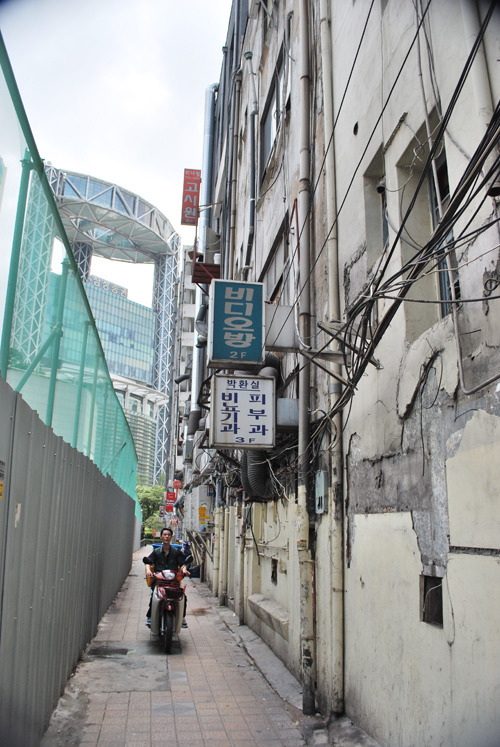 The entire north side of a huge stretch of Pimatgol just west of the spaceship better known as the Samsung Securities Tower was recently demolished.
The entire north side of a huge stretch of Pimatgol just west of the spaceship better known as the Samsung Securities Tower was recently demolished.
But these alleys are quickly becoming relegated to Seoul’s past. In the 1980s the area was marked for “urban renewal,” and a big bank and the iconic Samsung Securities Tower created impressive barriers along Pimatgol’s path. In 2004, a six-month protest by shopkeepers wasn’t successful in preventing another block from being razed and replaced. A few restaurants made new homes in the uninspired “Jongno Town” tower. But customers complain that the food just doesn’t taste the same.
 What remains of what was one of the best stretches of Pimatgol, demolished in May 2009 (Click here for larger).
What remains of what was one of the best stretches of Pimatgol, demolished in May 2009 (Click here for larger).
A slow decline followed until May 2009, when the half-block immediately behind the Kyobo Tower, considered the most picturesque and best preserved part of the alley, was demolished. Basically, the entire section from Kyobo to Jonggak Station is gone.
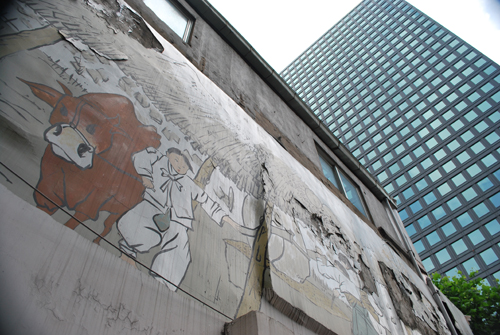 More shiny glass towers to come shortly.
More shiny glass towers to come shortly.
It’s true that what remains of Pimatgol is mostly dirty and uncharmed. But it’s a shame that efforts weren’t made to preserve this historically significant slice of seongmin (성민), or working class life. I understand Korea’s insatiable desire to tear down the old to build gleaming towers of steel and glass, but why not spend a fraction of that on preserving one-of-a-kind places like Pimatgol?
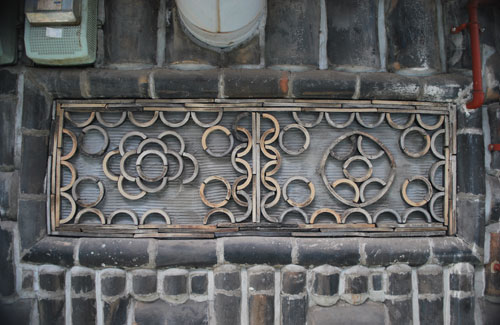
Today, everything in the area feels huge. Both Jongno and Gwanghwamun are among the city’s widest thoroughfares, and high rises flank each side. Small, derelict shops along a narrow alleyway seem out of place. But a mix of old and new, different sizes and shapes helps residents and travelers alike to feel an intimacy with a city – something that a uniform grid of business towers simply can’t do.
 Less known, the area east of the Boshingak Bell Pavilion is the longest remaining stretch of Pimatgol.
Less known, the area east of the Boshingak Bell Pavilion is the longest remaining stretch of Pimatgol.
If you want to see a piece of Pimatgol before it’s all gone, you’d better hurry. Of what’s left, the best place is actually across the street between Jongmyo Shrine (종묘) and Tapgol Park (탑골공원). Take a seat, eat a meal, and wander down one of Seoul’s most historic and endangered trails.
Getting There:
→ Take subway line 5 to Gwanghwamun Station (exit 2) and walk towards Kyobo Book Store. An entrance to Pimatgol starts underneath the Jongno Town building.
(A version of this text aired on KBS World Radio on July 1, 2009.)



I am so glad to have landed on your site. Truly enjoyed your entries and especially the videoblogs. And I agree with you that it’s the old/past that is charming and I am sure many of us return to Seoul for that piece of history and culture instead of its many skyscrapers.
By: solotune on 16 August 2009
at 21:14
Hi Solotune,
Thanks for your note. As Seoul creates admittedly interesting and useful new plazas and public spaces, let’s hope they also keep a lot of the old, too. Best, Matt
By: Matt Kelley on 16 August 2009
at 23:05